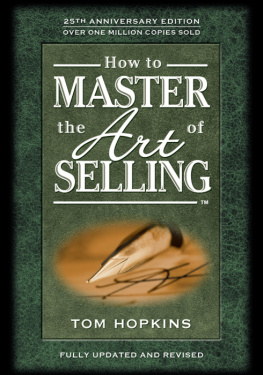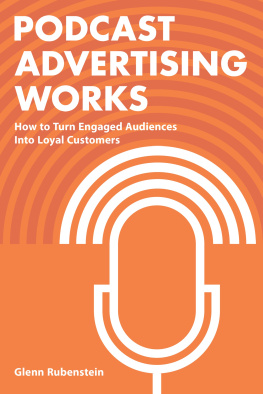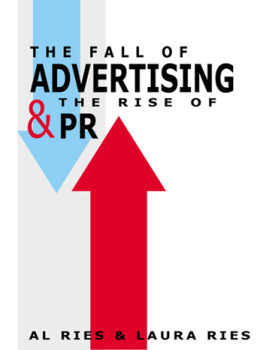

Copyright 1966 by Crain Communications, Inc. All rights reserved. Except as permitted under the United States Copyright Act of 1976, no part of this publication may be reproduced or distributed in any form or by any means, or stored in a database or retrieval system, without the prior written permission of the publisher.
ISBN: 978-0-07-178480-1
MHID: 0-07-178480-2
The material in this eBook also appears in the print version of this title: ISBN: 978-0-84-423101-3, MHID: 0-84-423101-0.
All trademarks are trademarks of their respective owners. Rather than put a trademark symbol after every occurrence of a trademarked name, we use names in an editorial fashion only, and to the benefit of the trademark owner, with no intention of infringement of the trademark. Where such designations appear in this book, they have been printed with initial caps.
McGraw-Hill eBooks are available at special quantity discounts to use as premiums and sales promotions, or for use in corporate training programs. To contact a representative please e-mail us at bulksales@McGraw-Hill.com.
TERMS OF USE
This is a copyrighted work and The McGraw-Hill Companies, Inc. (McGraw-Hill) and its licensors reserve all rights in and to the work. Use of this work is subject to these terms. Except as permitted under the Copyright Act of 1976 and the right to store and retrieve one copy of the work, you may not decompile, disassemble, reverse engineer, reproduce, modify, create derivative works based upon, transmit, distribute, disseminate, sell, publish or sublicense the work or any part of it without McGraw-Hills prior consent. You may use the work for your own noncommercial and personal use; any other use of the work is strictly prohibited. Your right to use the work may be terminated if you fail to comply with these terms.
THE WORK IS PROVIDED AS IS. McGraw-Hill AND ITS LICENSORS MAKE NO GUARANTEES OR WARRANTIES AS TO THE ACCURACY, ADEQUACY OR COMPLETENESS OF OR RESULTS TO BE OBTAINED FROM USING THE WORK, INCLUDING ANY INFORMATION THAT CAN BE ACCESSED THROUGH THE WORK VIA HYPERLINK OR OTHERWISE, AND EXPRESSLY DISCLAIM ANY WARRANTY, EXPRESS OR IMPLIED, INCLUDING BUT NOT LIMITED TO IMPLIED WARRANTIES OF MERCHANTABILITY OR FITNESS FOR A PARTICULAR PURPOSE. McGraw-Hill and its licensors do not warrant or guarantee that the functions contained in the work will meet your requirements or that its operation will be uninterrupted or error free. Neither McGraw-Hill nor its licensors shall be liable to you or anyone else for any inaccuracy, error or omission, regardless of cause, in the work or for any damages resulting therefrom. McGraw-Hill has no responsibility for the content of any information accessed through the work. Under no circumstances shall McGraw-Hill and/or its licensors be liable for any indirect, incidental, special, punitive, consequential or similar damages that result from the use of or inability to use the work, even if any of them has been advised of the possibility of such damages. This limitation of liability shall apply to any claim or cause whatsoever whether such claim or cause arises in contract, tort or otherwise.
Foreword
S ome one is always reprinting Claude Hopkins.
In 1923 he wrote a slender book which was published by the advertising agency of Lord & Thomas (lineal antecedent of the Foote, Cone & Belding advertising agency of today). He called it Scientific Advertising, and almost 30 years later it was re-published by Alfred Politz, eminent researcher and devotee of scientific marketing and advertising, because the most concentrated wealth of useful discoveries [about advertising] was presented by Claude Hopkins and because present-day advertising research has a long way to go before it reaches the level of Claude Hopkins contributions to efficient advertising.
In 1927 Mr. Hopkins wrote an autobiographical work, My Life in Advertising, which first was serialized in Advertising and Selling magazine and subsequently was published in book form by Harper. In 1933 you could buy a copy [even one personally autographed by his widowClaude had died in 1932] for 10 cents at almost any secondhand book store.
But by 1946 Advertising and Selling was reprinting the volume, with an interpretive foreword by Walter Weir, who concluded:
There are few pages in My Life in Advertising which do not repay careful studyand which do not merit rereading. Before your eyes, a successful advertising life is livedwith all that went to make it successful. The lessons taught are taught exactly as they were learned. They are dished up dripping with life. It is not a book, it is an experienceand experience has always been the great teacher.
* * *
So here we are again, reprinting Claude Hopkins, in an edition which contains both Scientific Advertising and My Life in Advertising for the edification of a generation of advertising men largely made up of the great grandchildren of Claude Hopkins and his contemporaries.
Hopkins is hopelessly out of date, and amazingly current. He was the outstanding copywriter and strategist of his time; he made $100,000 a year and more writing advertising when that kind of money was important even to the U. S. Treasury. He talked about scientific advertising in an era when there was very little science, and much of what he says seems terribly dated to the sophisticates of today. Some of it, indeed, is dated, or disproven; times and circumstances have changed. But despite it all, Claude Hopkins laid down guidelines that are too important, too eternal, to be forgotten.
The reader will find himself alternately shaking his head in violent disagreement, and applauding vigorously in complete agreement. He will be annoyed at Hopkins conceit and arrogance, intrigued with his stories, and impressed with his short, staccato sentencesa pre-Flesch example of the best in punching home a message. Short. Simple. To the point. Like this, from the first chapter of his autobiography:
I am sure I would fail if I tried to advertise the Rolls-Royce, Tiffany & Co. or Steinway pianos. I do not know the reactions of the rich. But I do know the common people. I love to talk to laboring-men, to study housewives who must count their pennies, to gain the confidence and learn the ambitions of poor boys and girls. Give me something which they want and I will strike the responsive chord. My words will be simple, my sentences short. Scholars may ridicule my style. The rich and vain may laugh at the factors which I feature. But in millions of humble homes the common people will read and buy. They will feel that the writer knows them. And they, in advertising, form 95 percent of our customers.
Claude Hopkins was an advertising pioneer. He blazed new trails. But he considered himself a cautious man, one who based his advertising on fixed principles and done according to fundamentals. That is why his words are always being reprinted. That is why neophyte and expert alike will find his words stimulating, helpful, entrancing.
S. R. Bernstein, President,
Advertising Publications, Inc.
Contents
One
Early influences
Two
Lessons in advertising and selling
Three
My start in business
Four
How I got my start in advertising
Five
Larger fields
Six
Personal salesmanship
Seven
Medical advertising
Eight
My Liquozone experience
Next page
















